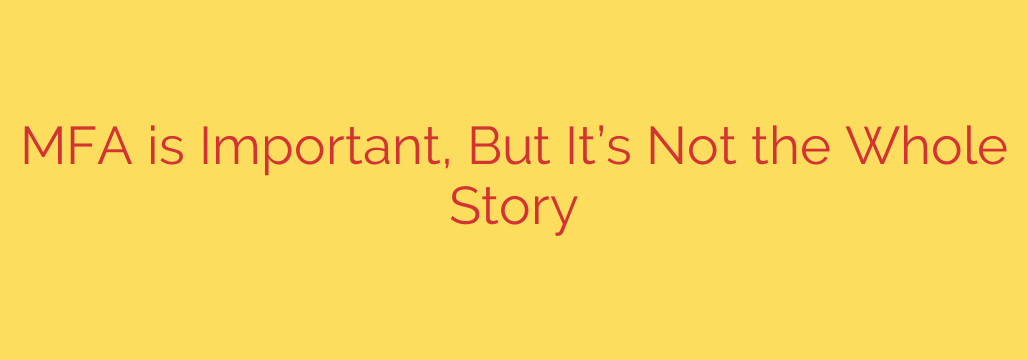
Beyond MFA: Protecting Your Accounts in a New Era of Cyber Threats
For years, cybersecurity experts have championed Multi-Factor Authentication (MFA) as a cornerstone of digital defense. The advice has been clear and consistent: enable MFA on every account possible to protect yourself from password theft and unauthorized access. This advice remains fundamentally sound—MFA is a critical security layer that has prevented countless data breaches.
However, the digital landscape is constantly evolving, and cybercriminals are relentless innovators. While MFA is still essential, relying on it as an impenetrable shield is a dangerous oversimplification. Attackers have developed sophisticated methods to circumvent this very protection, meaning we must adapt our security posture once again.
Understanding how these attacks work is the first step toward building a more resilient defense.
The Cracks in the Armor: How Attackers Bypass MFA
Threat actors are no longer just trying to guess your password; they are actively targeting the MFA process itself. They primarily use a combination of technical deception and psychological manipulation to trick users into granting them access.
Here are the most common and effective MFA bypass techniques seen today:
MFA Fatigue (or “Prompt Bombing”): This is a brute-force attack on human patience. After stealing a user’s password, the attacker repeatedly triggers MFA login notifications on the user’s smartphone. The goal is to create “notification fatigue.” Buried under a deluge of push alerts, the user might accidentally approve a request or approve it out of sheer frustration just to make the notifications stop. A single, careless tap is all it takes to open the door.
Adversary-in-the-Middle (AitM) Phishing: This is arguably the most dangerous method. The attacker creates a pixel-perfect replica of a legitimate login page (like for Microsoft 365 or Google Workspace) and tricks the user into visiting it via a phishing email or text. The user enters their username and password, which are passed to the real service by the attacker’s server. The real service then sends an MFA prompt to the user. When the user approves it, the attacker’s server intercepts the final piece of the puzzle: the session cookie. This cookie proves the user has successfully authenticated, allowing the attacker to access the account without needing the password or MFA device again until the session expires.
Social Engineering: Classic manipulation remains highly effective. An attacker might call a user, posing as an IT support technician. They’ll claim there is a security issue and that they need the user to read back the MFA code they just sent to their phone. By creating a sense of urgency and authority, they trick the user into willingly handing over the key to their account.
SIM Swapping: While more complex, SIM swapping is a serious threat, especially for MFA delivered via SMS text message. An attacker tricks a mobile carrier into transferring a victim’s phone number to a SIM card they control. Once they have control of the number, all incoming calls and texts—including MFA codes—are sent directly to the attacker.
Fortifying Your Defenses: A Layered Security Strategy
Recognizing that MFA is not a silver bullet is crucial. The goal now is to build layers of defense that account for these new attack vectors. This proactive approach, often aligned with a Zero Trust security model, assumes that no user or device is inherently trustworthy.
Here are actionable steps you can take to significantly upgrade your security beyond basic MFA:
Embrace Phishing-Resistant MFA: Not all MFA is created equal. The strongest forms are designed to defeat AitM attacks. Prioritize the use of FIDO2-compliant hardware keys (like YubiKeys) or platform authenticators like Windows Hello and Apple Passkeys. These methods tie your login authentication directly to the legitimate website, making it impossible for a fake phishing site to intercept the session.
Enable Advanced MFA Features: If you use push-based MFA, look for enhanced security options. One of the most effective is “number matching.” When you log in, the service displays a two-digit number on the screen, and you must type that same number into the authenticator app on your phone. This forces active engagement and prevents accidental approvals from prompt bombing.
Cultivate a Culture of Security Awareness: Technology alone is not enough. Train yourself and your teams to be suspicious. Never approve an MFA request you did not initiate. Be wary of unsolicited calls from “IT” asking for codes. Report phishing emails immediately. A vigilant human is one of your best lines of defense.
Implement Robust Monitoring and Policies: For businesses, it’s critical to monitor for suspicious activity. Use Conditional Access policies to restrict logins based on location, device health, and network. An employee suddenly logging in from an unusual country at 3 AM should trigger an alert or an automatic block, even if MFA was satisfied. This context-aware security can stop an attacker who has stolen a valid session cookie.
MFA remains an indispensable part of modern cybersecurity. But it’s time to treat it as the powerful component it is—not the entire solution. By understanding its limitations and layering stronger, phishing-resistant technologies and vigilant human oversight on top, we can build a defense truly ready for the threats of today and tomorrow.
Source: https://www.bleepingcomputer.com/news/security/mfa-matters-but-it-isnt-enough-on-its-own/








